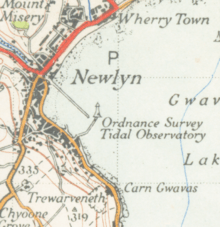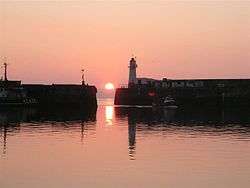Newlyn
Coordinates: 50°06′04″N 5°33′11″W / 50.101°N 5.553°W
Newlyn (Cornish: Lulyn: Lu 'fleet', Lynn/Lydn 'pool') is a seaside town and fishing port in southwest Cornwall, England.[1]
Newlyn lies on the shore of mounts bay and forms a conurbation with the neighbouring town of Penzance and is part of Penzance civil parish, and is the southernmost town on the British mainland (though not the most southerly settlement). The principal industry in Newlyn is fishing, although there are also a wide variety of yachts and pleasure boats, in the harbour, as Newlyn is becoming an increasingly popular holiday destination, with many pubs and restaurants. Although the parish is now listed under Penzance there is an electoral ward in separate existence called Newlyn and Mousehole. The population at the 2011 census was 4,432.[2]
Toponymy
The settlement is recorded as Nulyn in 1279 and as Lulyn in 1290, and the name is thought to be derived from the Cornish for "pool for a fleet of boats" which is thought to refer to the shallows offshore also called Gwavas Lake, traditionally the principal mooring for the fishing fleet in the area.[3]
History
Before the rise of Newlyn as an important settlement the landing rights and most property within the Newlyn area were owned by the Manor of Alverton. Newlyn's history has been strongly linked to its role as a major fishing port. The natural protection afforded by the Gwavas Lake (an area of seawater in Mount's Bay) led to many local fishermen using this area as a preferred landing site.[4]
Before the 19th century, "Newlyn" referred only to the area near the old quay. The part of the village that now contains the fish market was known as "Streetanowan", this was separated at high tide from "Newlyn Town" the site of the lower part of the modern harbour being reclaimed land and formerly a beach. In fact Newlyn comprises three discrete hamlets all previously separated by bodies of water, being Tolcarne (Tal Carn: Brow of the Rocks), Street-an-Nowan (Steet-an-Awan: River Street) and Trewarveneth (Farm/Manor on the Hill).[5]
Newlyn (like Mousehole) was part of the ancient parish of Paul. It was common for villagers to climb the relatively steep route from "Newlyn Cliff" to Paul via the area which is now known as Gwavas to worship at Paul Church. Until the mid-20th century an ancient stone cross was present on this route at "Park an Grouse" (The Field of the Cross), this cross was one site of veneration of the Cornish sea deity Bucca, (others were the beaches of Newlyn and Mousehole) the name 'Bucca' has often been used as a nickname for people resident in Newlyn: the location of the cross is now unknown.[6]
In 1851 Newlyn became the separate ecclesiastical parish of Newlyn St Peter.[7]
Earlier history
The Spanish Raid of 1595 destroyed Penzance, Mousehole and Paul as well as Newlyn.
In 1620 the Mayflower stopped off at Newlyn old quay to take on water.[8] A plaque on the quay reads:
To the memory of Bill Best Harris 1914 – 1987 Historian and son of Plymouth whose researches indicated that the MAYFLOWER 16 – 8 – 1620 docked at the Old Quay Newlyn for water and supplies making it the last port of call in England The water supply at Plymouth being the cause of fever and cholera in the city Let debate begin[9]
In 1755, the Lisbon earthquake caused a tsunami to strike the Cornish coast more than 600 miles (970 km) away. The sea rose ten feet in ten minutes at Newlyn, and ebbed at the same rate. The 19th century French writer, Arnold Boscowitz, claimed that "great loss of life and property occurred upon the coasts of Cornwall".[10]
Newlyn and the Cornish language
Newlyn, along with nearby Mousehole and Paul, was the last stronghold of the Cornish language, presumably due to the strength of its fishing fleet. William Gwavas, James Jenkins,[11] Nicholas Boson, Thomas Boson, John Boson, John Keigwin, and John Kelynack Jnr. had roots in or strong links with the district. Subsequently several antiquarians including Prince Louis Lucien Bonaparte,[12] Daines Barrington, Georg Sauerwein and Henry Jenner who all collected Cornish writings or sayings, and the latter two became proficient in its use.
Modern history
In the 1880s a number of artists flocked to the town and formed an artists' colony.[13] The painters of Newlyn came to be known as the Newlyn School.
In 1896 Newlyn was the scene of the Newlyn riots following protests over the landing of fish on a Sunday by fishermen from the North of England, the local Cornish fishermen being members of the Methodist church and as such strong supporters of sabbatarianism.

In 1915, the Ordnance Survey tidal observatory was established in the harbour and for the next six years measurements of tidal height were taken every 15 minutes.[14]
In 1937, the fishing vessel Rosebud sailed to London to deliver a petition to the Minister of Health on behalf of those villagers whose homes were threatened under the government's slum clearance scheme.
During the Second World War Newlyn was a base for the Air Sea Rescue craft covering the Western Approaches. The harbour was bombed during the war, hitting the collier Greenhithe, which was beached in the harbour at the time and supplied coal to the east coast drifters, which travelled to Newlyn during the mackerel fishing season between the wars.[15] Reporting the event on the "Germany Calling" propaganda broadcast Lord Haw-Haw announced that the Luftwaffe had sunk a British cruiser in Newlyn Harbour.
In 2014 indie band the Hit Parade released Cornish Pop Songs, an album containing several songs about Newlyn including "Rainy Day in Newlyn" and "The Ghost of the Fishing Fleet".[16]
Local government
In 1894 Newlyn became part of Paul Urban District. The urban district was abolished in 1934 and Newlyn was absorbed into the municipal borough of Penzance.[17] Penzance Municipal Borough was itself abolished in 1974 under the Local Government Act 1972, and Newlyn became part of the new Penwith District. The former borough was unparished until 1980. The unparished area was formed into a civil parish in 1980,[18] and the new Penzance parish council elected to call itself a town council. Penwith District was abolished in 2009, and Newlyn now falls under the unitary Cornwall Council.
Geography
Newlyn is located in southern Cornwall, just south of Penzance. It lies along the B3315 road which connects it to Land's End. Paul and Mousehole lie to the south.
The Ordnance Survey, the United Kingdom's mapping agency, bases all elevations including mapped contour lines and spot heights on the mean sea level at Newlyn (see Ordnance Datum).[19] The mean sea level data was calculated from hourly readings of the sea level between 1 May 1915 and 30 April 1921.[19]
Economy

Newlyn's economy is largely dependent on its harbour and the associated fishing industry; Newlyn Harbour is the largest fishing port in England.[20] The port was a major catcher of pilchard until the 1960s. Today, a few vessels have resumed pilchard fishing and use a modern version of the ring net. The largest vessels are beam trawlers owned by W. Stevenson and Sons Ltd, one of Cornwall's largest fish producers;[21] most of the other vessels are owned by their skippers. The company based in the Old Pilchard Works today are major supplies of Cornish sardines and mixed species fish.[20]
Food and music festival
Newlyn is home to the Newlyn fish festival [22] which hosts live music, cooking demonstrations, and various marquees selling local produce.
Notable landmarks
The UK National Tidal and Sea Level Facility (NTSLF) maintains a tidal observatory at Newlyn, and the UK Fundamental Benchmark is maintained there.[23]
Newlyn was made famous in the 1880s and 1890s for its Newlyn School artists' colony, including the painters Thomas Cooper Gotch, Albert Chevallier Tayler and Henry Scott Tuke. The current largest collection of work by the Newlyn School is held by Penlee House Gallery and Museum in nearby Penzance. A collection of Newlyn Copper, produced from circa 1890 – 1920, is on view at Penlee House. Newlyn is the home of Newlyn Art Gallery which houses a collection of modern art.
Local government
For the purposes of local government, Newlyn is part of the Penzance Civil Parish and returns five councillors to Penzance Town Council. The principal local authority in the area is Cornwall Council.
Notable residents
- Ray Atkins, artist
- Richard Cook, artist
- Sir Terry Frost, artist
- Thomas Cooper Gotch
- Robert Hichens
- Charles Holroyd
- W. S. Lach-Szyrma, clergyman and scholar
- William Lovett, political agitator
- John Pearson
- Brenda Wootton, singer
- Allan G. Wyon, artist
See also
References
- ↑ Ordnance Survey: Landranger map sheet 203 Land's End ISBN 978-0-319-23148-7
- ↑ "Ward population 2011 census". Retrieved 10 February 2015.
- ↑ Mills, A. D. (1991). The Popular Dictionary of English Place-Names. Parragon Book Service Ltd & Magpie Books. p. 241. ISBN 0-7525-1851-8.
- ↑ "The Harbour". Retrieved 2009-03-27.
- ↑ Morrab Library Archives
- ↑ Hardie, Melissa (June 1995). 100 years in Newlyn: diary of a gallery. Hypatia Publications. p. 18. ISBN 978-1-872229-22-5. Retrieved 28 May 2011.
- ↑ Genuki website: Paul
- ↑ "Tregwary Cottage: Some "interesting" facts about Newlyn". tregwarycottage.co.uk. Retrieved 15 August 2012.
- ↑ "Plaque to historian Bill Best Harris of Plymouth". picturepenzance.com. April 2005. Retrieved 2 December 2014.
- ↑ "Timeline of Cornish History – The Lisbon Earthquake".
- ↑ Ellis, P. Berresford (1974) The Cornish Language and its Literature. London: Routledge; pp. 92, 108–11
- ↑ See Dolly Pentreath's memorial at Paul.
- ↑ Cherry, Deborah (1993). Painting women: Victorian women artists. Routledge. p. 183. ISBN 978-0-415-06053-0. Retrieved 28 May 2011.
- ↑ "Newlyn Tidal Observatory".
- ↑ Pool, Peter A. S. (1974). The history of the town and borough of Penzance. Corporation of Penzance. Retrieved 28 May 2011.
- ↑ http://www.westbriton.co.uk/Indie-originals-ensure-Kernow-s-Hit-Parade/story-21262225-detail/story.html
- ↑ Vision of Britain website: Paul UD
- ↑ "A complete list of orders affecting Cornwall County from 1973 to the present". Database of Local Government Orders. Local Government Boundary Commission for England. Retrieved 7 June 2012.
- 1 2 Lee, E. Mark; Clark, Alan R. (20 June 2002). Investigation and management of soft rock cliffs. Thomas Telford. p. 312. ISBN 978-0-7277-2985-9. Retrieved 28 May 2011.
- 1 2 "The Pilchard Works". Retrieved 28 May 2011.
- ↑ Key British enterprises: Britain's top 50,000 companies. Dun & Bradstreet. February 1994. p. 606. ISBN 978-0-901491-71-8. Retrieved 28 May 2011.
- ↑ "Newlyn fish festival".
- ↑ National Tidal and Sea Level Facility website. Retrieved June 2010
External links
| Wikimedia Commons has media related to Newlyn. |
| Wikivoyage has a travel guide for Newlyn. |
- Information on the regeneration of Newlyn Harbour and connected organisations
- Information on the contemporary Newlyn School of Art an Arts Council funded not for profit organisation
- Newlyn at DMOZ
- NTSLF page about the Newlyn Tidal Observatory and the Fundamental Benchmark

